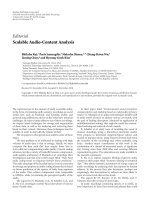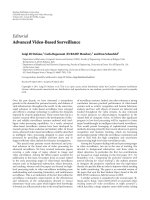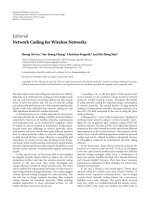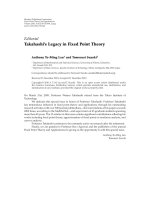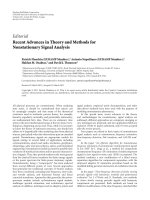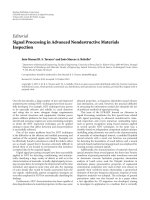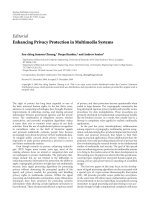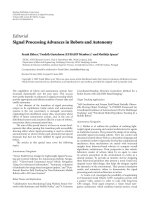Báo cáo hóa học: " Editorial Synchronous Paradigm in Embedded Systems" ppt
Bạn đang xem bản rút gọn của tài liệu. Xem và tải ngay bản đầy đủ của tài liệu tại đây (419.79 KB, 2 trang )
Hindawi Publishing Corporation
EURASIP Journal on Embedded Systems
Volume 2007, Article ID 32903, 2 pages
doi:10.1155/2007/32903
Editorial
Synchronous Paradigm in Embedded Systems
Alain Girault,
1
S. Ramesh,
2
and Jean-Pierre Talpin
1
1
INRIA, France
2
IIT Bombay, India
Received 19 June 2007; Accepted 19 June 2007
Copyright © 2007 Alain Girault et al. This is an open access article distributed under the Creative Commons Attribution License,
which permits unrestricted use, distribution, and reproduction in any medium, provided the original work is properly cited.
Synchronous languages were introduced in the 1980s for pro-
graming reactive systems. Such systems are characterized by
their continuous reaction to their environment, at a speed
determined by the latter. Reactive systems include embed-
ded control software and hardware. Synchronous languages
have recently seen a tremendous interest from leading com-
panies developing automatic control software and hardware
for cr itical applications. Industrial success stories h ave been
achieved by Schneider Electric, Airbus, Dassault Aviation,
Snecma, MBDA, Arm, ST Microelectronics, Texas Instru-
ments, Freescale, Intel, and so on. The key reason for the
success is in the rigorous mathematical semantics provided
by the synchronous approach that allows programers to de-
velop critical software and hardware in a faster and safer
way.
Indeed, an important feature of synchronous paradigm is
that the tools and environments supporting development of
synchronous programs are based upon a formal mathemat-
ical model defined by the semantics of the languages. The
compilation involves the construction of these formal mod-
els, and their analysis for static properties, their optimization,
the synthesis of executable sequential implementations, and
the automated distribution of programs. It can also build a
model of the dynamical behaviors, in the form of a transition
system, upon which is based the analysis of dynamical prop-
erties, for example, through model-checking-based verifica-
tion, or discrete controller synthesis. Hence, synchronous
programing is at the cross-roads of many approaches in
compilation, formal analysis and verification techniques, and
software or hardware implementations generation.
We invited for this special issue of the journal original pa-
pers on all aspects of the synchronous paradigm for embed-
ded systems, including theory and applications. We received
initially 9 papers for the special issue. After the first round of
reviews, 7 papers were short-listed or recommended for ma-
jor revision or resubmission. Al l the authors came back with
resubmissions which were subjected to an additional round
of rigorous reviews, which resulted in the 5 papers that ap-
pear in this special issue.
In the paper titled “A domain-specific language for mul-
titask systems, applying discrete controller synthesis” by G.
Delaval and E. Rutten, a programing language for multi-
tasking real-time control systems called Nemo is proposed.
Nemo specifies a control layer, on top of the computation
layer underlying an embedded application. The idea is to
specify a set of resources with usage constraints, a set of
modes of each task with its resource requirements, and a set
of applications sequencing the tasks, as well as some global
temporal constraints on task interactions, so that an appli-
cation specific task handler can be generated automatically,
obeying all the constraints. The task handler is nothing but
an application specific scheduler. It really specifies when to
start and stop tasks, so as to meet the control objectives by
staying within specified resource constraints. It is generated
using the technology of optimal control synthesis for discrete
event systems.
In the paper “Removing cycles in Esterel programs,” the
authors J. Lukoschus and R. von Hanxleden present a new
algorithm to transform a cyclic but causal Esterel program
(hence constructive) into an equivalent acyclic one. The
transformation is performed at the source level. Technically,
the detection of the cyclic dependencies is per formed thanks
to a structural induction on the Esterel source program,
while the cycle elimination is performed by iteratively replac-
ing signals involved in cycles by signal expressions involving
other signals not involved in cycles. This algorithm has been
implemented in the Columbia Esterel Compiler, and the au-
thors have extensively tested it against other Esterel compilers
(namely V5, and V7, with and without the usual optimiza-
tions). The results show that most of the signals added by the
2 EURASIP Journal on Embedded Systems
transformation are in fact removed afterwards by the Esterel
compiler.
In the paper “Code generation in the Columbia Esterel
compiler,” by S. A. Edwards and J. Zeng, the authors present
the three main code generation algorithms for Esterel, based,
respectively, on program dependence graphs (PDG), dy-
namic lists (DL), and a virtual machine (VM). This presen-
tation is very clear and pedagogical. The PDG-based code
generation takes advantage of the possibility to reorder state-
ments to remove unnecessary dependencies, therefore avoid-
ing as much context switching as possible. The DL-based
code generation tries to avoid generating code for portions of
programs that w ill not run in the future. The VM-based code
generation attempts to minimize the code size by employ-
ing an Esterel-dedicated virtual machine. The authors have
compared the size and speed of the code generated by the
three algorithms with that generated by the V3, V5, and V7
compilers. The VM-based code is the slowest while the PDG-
based code is the fastest. Regarding the size, the VM-based
code is the smallest for the large Esterel programs, while the
DL-based code is the largest, but never as big as the V5 or V3
generated code.
In the paper “Array iterators in lustre: from a language
extension to its exploitation in validation,” by L. Morel, the
author presents an extension of the synchronous dataflow
language lustre, with array iterators allowing a simple and
efficient way to write programs that manipulate arrays. The
extension has been designed as a compromise between ex-
pressivity and abilit y to be compiled into reasonable sequen-
tial code: an iterator leads to a for-loop in the target lan-
guage. This work covers all the aspects traditionally covered
by Lustre: code generation and proof. A proof environment
has been prototyped by the author to assist the user in the
application of the proposed methodology. The presented ex-
tensions have been successfully applied on a n industrial case
study and have been adopted by the tool provider for the
forthcoming release of Scade 6.
In the paper “Formal methods for scheduling of latency-
insensitive designs,” by J. Boucaron, R. de Simone, and J V.
Millo, the authors address the design of latency-insensitive
architectures. They provide a solution for balancing the la-
tencies on paths in a circuit under design. This is done by
analyzing the design using weighted event/marked graph,
where the computation nodes are shown as vertices, and la-
tencies are marked on the arcs. Relay stations are inserted
based on the latencies. To ensure that the graph is equal-
ized, new elements called fractional registers are inserted on
the faster arc to slow them down. These fractional registers
are mostly used in graphs with nodes that have loops. Their
operation is statically scheduled based on the flow of tokens
through the path. The description of the relay station and
shell-wrapper circuitry is provided.
ACKNOWLEDGMENTS
We thank the authors for submitting their work for this spe-
cial issue. We are indebted to the reviewers who spent con-
siderable time to thoroughly review the papers and help im-
prove the quality of presentations and the issue. We also
thank the Editor-in-Chief for encouraging us to bring out
this special issue.
Alain Girault
S. Ramesh
Jean-Pierre Talpin


